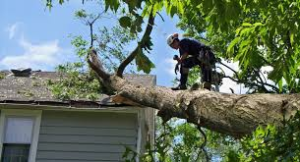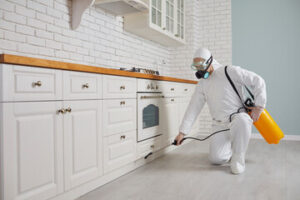An exterminator is a professional who helps to get rid of pest infestations in homes and businesses. They use a variety of strategies to treat the pests, including chemicals and traps. They also advise clients on preventing future pest infestations by improving sanitation and sealing cracks and crevices. Click Here to learn more.
Exterminators are experts in the biology and habits of pests. They use their knowledge to help people rid their homes and businesses of pests. Their job includes inspecting buildings and structures to determine what pests are infesting them. They also create detailed pest management plans for the area infested by the pests. They are trained to use various techniques, including pesticides and traps.

When an exterminator arrives at a customer’s home, they start their day by greeting the customer and thoroughly inspecting the property. This involves looking under sinks, behind furniture, and in corners to find where the pests are hiding. Then, they use their tools to kill the pests and seal any entry points.
Pests are a serious health risk and can damage buildings and other infrastructure. They can cause disease, spread germs, and even trigger allergic reactions in humans. In addition, they can also contaminate food and water. Exterminators can control the problem by using a wide range of methods, including traps, pesticides, and natural remedies.
Many people think that being an exterminator is a glamorous profession, but the truth is that it’s not for everyone. This career requires a lot of physical labor, and you need to be able to work in all kinds of weather. Besides, there are many different types of pests, and each one requires a different treatment.
Historically, exterminators relied on poisons to kill pests, but today, most companies prefer to use more ecologically friendly approaches to pest control. While chemicals are still a vital part of the industry, it’s also important to educate the public about preventive pest control. This will reduce the demand for poisons and save money in the long run.
Exterminators usually work in residential settings, and they must be able to navigate tight spaces, climb stairs, and work in attics or basements. They also need to be able to perform routine maintenance on the properties they inspect, such as fixing cracks or gaps and installing weather stripping. They may also need to work with homeowners to prevent future pest infestations.
Work environment
Exterminators work in a variety of environments. The majority of these professionals work in buildings and homes to prevent the infestation of insects and rodents. They also use various methods to control pests in the environment, such as chemical treatments and traps. In addition, these workers may provide recommendations to their clients on ways to improve sanitation and reduce future pest problems.
Working as an exterminator is a satisfying career. It is an exciting and challenging job that makes a difference in the lives of people all over the world. However, the work can be stressful. Several factors contribute to stress in this job, including the need for organizational skills and the inability to express oneself creatively. In addition, the work is often physically demanding and requires a high level of physical stamina.
Despite these challenges, it is important for an exterminator to stay positive and be resilient. They must maintain a good attitude, as well as good customer service skills to make their business successful. Additionally, they need to be able to keep accurate records of their work and financial transactions. In order to do so, they need to be able to read and write. In addition, they should be able to operate computer software and other equipment necessary for their job. Lastly, they need to be able to communicate effectively with their coworkers. They must also be able to use pesticides and other chemicals safely. They should be aware of the potential health hazards associated with these substances, such as cyanide poisoning and organophosphate poisoning.
Training requirements
A career in pest control offers a variety of opportunities for those interested in working in the industry. Exterminators are needed in both residential and commercial environments, where they address insect and rodent infestations using a variety of methods. This can include chemical treatments, traps, and other pest control techniques. They also offer recommendations to clients on how to prevent pests in their homes and businesses, including improving sanitation and sealing cracks and gaps.
Those who wish to become exterminators must undergo the proper training to gain the necessary skills and knowledge. This training usually involves attending a vocational school or community college, where they can learn about the various pests and their habits. This information will help them identify the best course of action to take in a given situation. It is also important for aspiring exterminators to gain on-the-job experience by working for a reputable pest control company.
In addition to education and on-the-job experience, aspiring exterminators must meet the licensing requirements for their area of work. Different regions may have different requirements, so prospective pest control professionals should research these details before pursuing this career path. In addition, exterminators should maintain their licenses and certification by participating in continuing education courses. This will help them keep up with new trends and ensure that they are aware of any changes in regulations or safety standards.
Aspiring exterminators should consider the physical and emotional demands of this occupation before deciding whether or not it is right for them. This career path can be physically demanding and stressful, since it requires working in confined spaces and dealing with distressed customers. It also involves handling chemicals and other hazardous materials, which can be dangerous to human health.
In order to be licensed in New York City, an exterminator must complete a pesticide applicator program that teaches them how to apply pesticides safely. In addition, they must pass a background check and drug test. Those who want to work in commercial buildings must obtain a Commercial Pesticide Applicator License, while those who specialize in treating wood-destroying insects must get a Structural Pest Control License.
Salary
If you have unwanted pests in your home, the best thing to do is hire a professional exterminator. These experts are trained in all the methods and products used for eradicating a variety of pests. They can also provide tips on how to prevent the infestation from reoccurring. Unlike DIY treatments, hiring a professional will usually yield better results and save you time in the long run.
The salary of an exterminator varies depending on the level of education, work experience, and any additional skills. In addition, the type of pests you specialize in can affect your salary. For example, if you specialize in termite removal, you can charge higher rates than someone who doesn’t. You can also increase your income by expanding your service offerings. For instance, you can offer add-on services like wildlife removal or preventive pest control measures to boost your earning potential.
Although it may not be the most glamorous job, an exterminator’s career can be rewarding and interesting. This is because there are many different types of pests and they can be found in a wide range of environments, from sewage systems to garbage disposal sites. Exterminators may also be required to enter confined spaces and use hazardous chemicals, which can pose health risks. In addition, they must have good physical stamina to stand and crouch for extended periods of time.
Pests are more than just nuisances; they can also spread disease. Mosquitoes can transmit malaria, rodents can carry hantavirus and yellow fever, and cockroaches can cause leprosy. They can also cause structural damage to homes and buildings. Pest control is a complex task, but it is necessary to protect the public’s health and property.
To increase your salary as an exterminator, consider increasing your level of education. Getting a bachelor’s degree in entomology can help you advance your career and earn more money. You can also get additional certifications to make yourself more valuable to your employer. Having excellent bookkeeping skills is also important because you will need to keep track of your hours worked, pest control techniques, and financial transactions.






